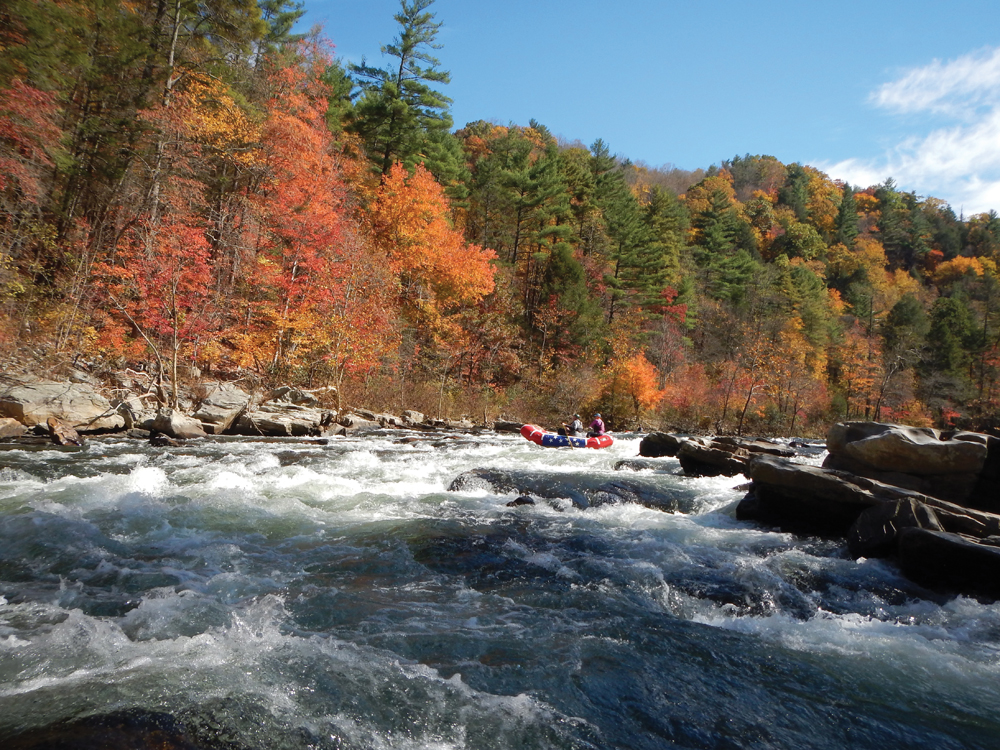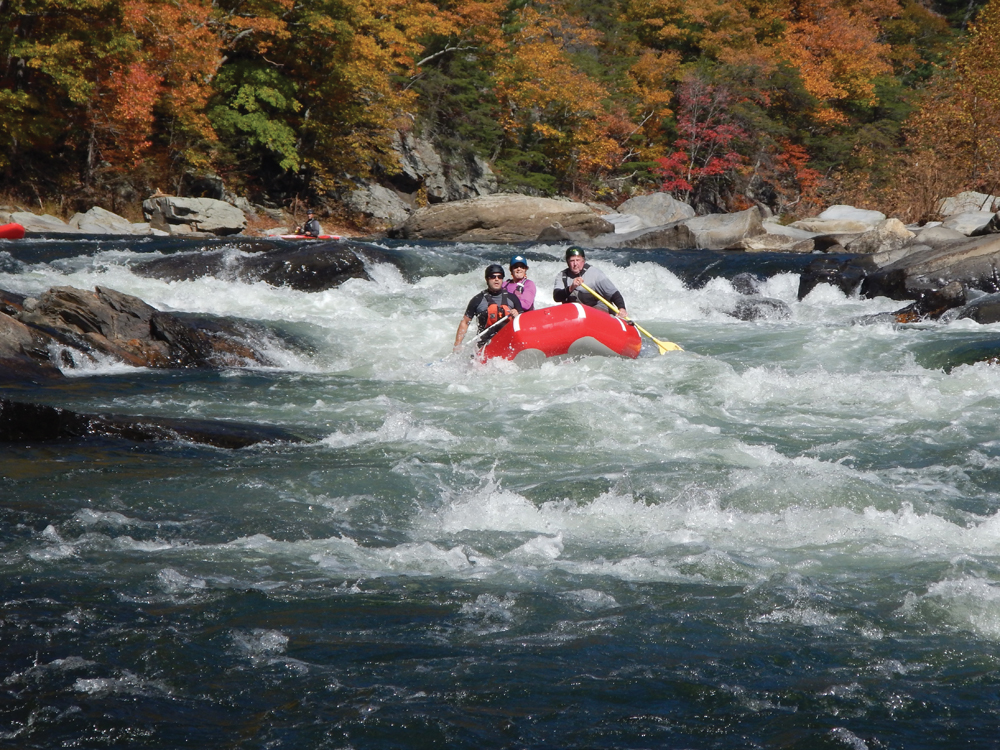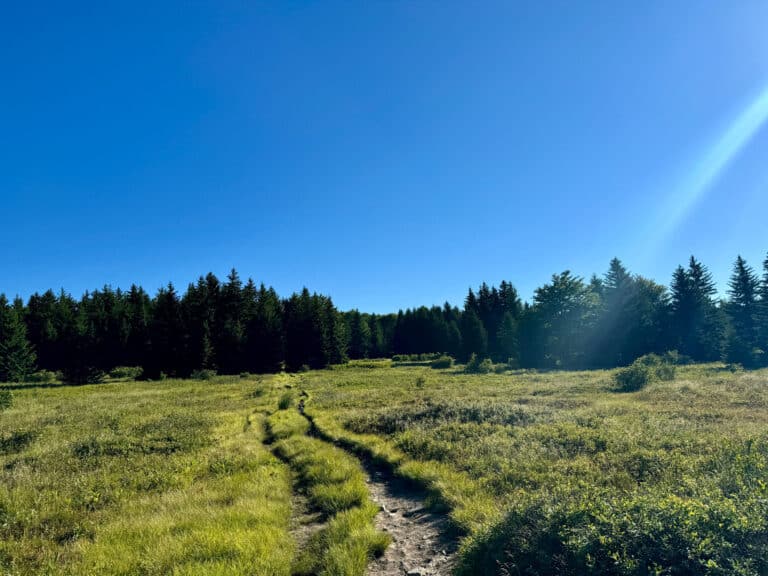Paddlers, filmmakers, and local citizens team up to nominate the Nolichucky as a Wild & Scenic River.
That the Nolichucky River is both wild and scenic seemed obvious enough on a brilliantly clear day last fall when I walked into its namesake gorge east of Poplar, N.C. The water level, which fluctuates widely in this dam-free stretch of the Nolichucky, was ideal for paddling, the water surging powerfully but remaining a clear, beer-bottle green in the channels between boulders. And though the landing at Poplar is little more than an hour’s drive from downtown Asheville, and this was the kind of sun-drenched afternoon that beckons paddlers, I counted precisely one small party of kayakers.
“The Nolichucky Gorge is as remote a place as some people will ever get to in their lives,” said Matt Moses, owner of Mountain River Guides & USA Rafts near Erwin, Tenn. “We see a remarkable amount of wildlife. One trip not too long ago witnessed an osprey pulling a fish out of the river, a mama bear and two cubs on the bank and a deer swimming, probably to get away from the bears. And right at the end, as if that wasn’t enough, we had an eagle fly right over.”
More than just Wild and Scenic
Along with checking essential boxes for federal designation as a Wild and Scenic River: beauty, pristine surroundings and unhindered flow-the upper Nolichucky claims other qualities that justify its listing. It generates more than $12 million in tourism revenue for the local economy, a figure that with a few tweaks to accommodate visitors could easily climb to nearly $17 million, a consultant recently found. Among the many cultural resources along its banks is the site of a classic moonshine-making, government-averse mountain settlement, the now-abandoned Lost Cove.
In fact, the U.S. Forest Service confirmed the Nolichucky’s worthiness for listing more than two decades ago, in 1994, when it named the stretch through the gorge as eligible for Wild and Scenic status, said Kevin Colburn, American Whitewater’s national stewardship director.
The only remaining gap, one that paddlers and local businesses have recently been working hard to fill, is political action.
“Eligibility is based on the river’s physical attributes, while designation is based on public and political will to see the river protected,” Colburn said. “It’s really all about public enthusiasm.”
Public Enthusiasm and Political Action
That has been growing for about two years, starting with conversations among guides and spreading to local business and political leaders. A petition on Change.org has been signed by more than 20,000 supporters, and a Facebook page links to a short film, This Is the Nolichucky, that highlights the river’s distinctive qualities. Entrepreneurs in Erwin, Tenn., a former railroad hub near the lower end of the gorge, have jumped on board, seeing listing as a crucial step in their effort to refashion their town as a center of outdoor tourism. The mayor of Erwin and leaders of surrounding Unicoi County have sent letters backing Wild and Scenic designation to federal lawmakers who must introduce a bill to make it happen.
“This all sprung organically,” Colburn said. “It was just a good idea that started resonating.”
That those federal lawmakers remain noncommittal is the main obstacle to securing Wild and Scenic status. But the job of convincing them has been made easier by the disappearance of traditional opposition from mining, agricultural and railroad industries, said Tyler Engle, executive director of the Joint Economic and Community Development Board of Unicoi County, home to the western portion of the gorge.
“We have presented this idea for the last couple of years,” he said, “and, really, we have not heard of any opposition.”
 Lobbying for the Nolichucky is easy because the river is so distinctive, so stunning.
Lobbying for the Nolichucky is easy because the river is so distinctive, so stunning.
Its tributaries, including the North Toe and Cane rivers, drain the slopes of two of the highest points in the East, Mount Mitchell and Roan Mountain. Near Huntdale, N.C., these tributaries join to form the Nolichucky, which flows west into the gorge— a deep gash in the spine of the Blue Ridge Mountains on the North Carolina-Tennessee border that could only have been created in an area with unique geology, said Philip Prince, a geologist with the state of Virginia and an avid paddler.
“That is a steepness and a magnitude of relief that’s only going to occur with a very quartz-rich bedrock, and it’s not a topography that you’re going to find anywhere else in Appalachia,” Prince said.
This hard rock also creates the erosion-resistant ledges and chutes that provide some of the most challenging rafting and kayaking in the East. The river descends an average of 31 feet per mile through the gorge, cascading down runs such as On the Rocks and Quarter Mile.
Unlike some of the Southeast’s most famously harrowing rivers—the dam-controlled Gauley, for example—the Nolichucky claims no Class V rapids. But its roughest passages can seem at least that treacherous in high water.
“Don’t get me wrong, I’ve been plenty scared on the Gauley,” said Chris Lennon, a USA Raft paddling and fishing guide who has extensive experience leading trips on both rivers. “But when the (Nolichucky) is erupting and it’s chaotic and there is all this debris and root balls floating by, I’ve definitely been more puckered up here.”
“That’s the beauty of a free-flowing river like the Nolichucky, it’s always changing. That and there’s no houses on the ridge tops. There’s no horns honking. There’s no cell service.”
The unspoiled condition
is a result not only of a topography that prohibits road building and limits trail construction—even the nearby Appalachian Trail skirts the gorge—but also, ironically, its most visible mark of civilization: the railroad that runs next to the river for the length of the gorge.
This stretch was part of the original 242-mile Clinchfield Railroad, a marvel of mountain-traversing engineering that connected Spartanburg, S.C. with Dante, Va. in 1909. The route was chosen because the gorge presented builders with a natural gap through the Blue Ridge and, said railroad historian Martha Erwin, because steam engines of the era needed a reliable water source for the frequent refilling of their tanks.
The Tennessee Valley Authority once identified the towns of Erwin and Poplar as prime sites for hydroelectric dams, according to Forest Service documents. These dams were never built, Lennon said, because by the time of the TVA’s formation in 1933 the rail line was well established as an economic powerhouse.
“The railroad took precedence over the TVA,” Lennon said. “It saved this gorge.”
And as the years passed and traffic on the line steadily decreased, paddlers and Forest Service employees came to see the tracks less as a man-made blight and more as a landmark.
In 1980, a federal study declined to recommend the Nolichucky for Wild and Scenic status
partly because the report stated, the railroad “significantly diminished” the river’s “scenic values.” In 1994, the Forest Service reversed this finding, determining that “the railroad is well-screened from the river by vegetation,” and that the railroad trestle crossing the river near Poplar “does not appreciably detract from the river’s outstandingly remarkable values.”
The tracks tucked into the base of the gorge’s southern wall, the rumble of occasional freights, the whistle blasts sounded by friendly engineers—all these sights and sounds have become highlights of rafting trips through the gorge, Moses said.
“The only sign of human intrusion is the railroad tracks, and who doesn’t love trains?”
The railroad—or at least its near demise—is also the reason business leaders who once seemed indifferent to the idea of Wild and Scenic listing are now all for it.
For decades, the city of 6,000 was home to one of the region’s largest rail terminals, said Jamie Rice, the city’s communications specialist: “Erwin really hung its hat on being a railroad town until three years ago.”
That was when CSX, the railroad giant that had absorbed the historic railroad in 1983, abruptly closed the terminal due to decreased demand for its primary cargo, coal.
The company immediately laid off 400 workers, most of them highly skilled and well-paid union members, Rice said. Another 200 CSX employees moved to take other jobs with the company.
“I thought, well, here we are, a railroad town without a railroad,” Erwin said.
To respond to the crisis, Rice, 36, who had recently moved from Asheville to her hometown of Erwin and invested in downtown property, teamed up with other like-minded business people to form an economic development group, RISE Erwin.
Casting about for a new economic identity,
“we looked out our windows and realized, my goodness, we are so blessed with all these natural assets that really, up to now, nobody has supported,” said Rice, who was later hired by the city of Erwin to promote the town.
The group started hosting events such a spring festival timed to accommodate thru-hikers on the nearby Appalachian Trail, offering beer, music, food trucks, podiatrists and massage therapists. Maybe the area’s biggest economic coup has been attracting Pyranha Kayaks, which recently relocated from Weaverville, N.C. to a site west of Erwin.
By the time CSX closed its terminal, Colburn had already begun quietly pursuing Wild and Scenic designation—an idea that had also been percolating in the mind of Curtis England, the manager of a Nantahala Outdoor Center outpost formerly based on the Nolichucky. He had learned of the Nolichucky’s eligibility status while studying for a degree in outdoor recreation. He had guided scientists on the river researching the endangered elktoe mussel, which can only live in clean, free-flowing rivers.
“It was a cumulative thing … a lot of different events that got me thinking that (permanent designation) is really a no-brainer,” he said.
England launched the Change.org petition in early 2017 and enlisted the support of other guides, including Lennon. One of Lennon’s first steps was to reach out to his well-connected boss, Moses, who took the idea to RISE.
Moses’s pitch to RISE—that Wild and Scenic status for the Nolichucky could cement the region’s identity as a destination for paddlers and anglers—
was persuasive partly because Congressional listing is such a rare distinction, Colburn said. Only four streams have been designated in western North Carolina, which, on the other hand, is home to 390 dams. Membership in the exclusive club of listed, free-flowing rivers, he said, “can definitely raise awareness as a point of pride for the area.”
But he and Moses added they don’t necessarily want to attract hordes of paddlers to the Nolichucky. A better outcome might be a sustainable flow, Colburn said, more like “drip irrigation,” less like “turning open a firehose of dollars.”
Many advocates of Wild and Scenic designation for the Nolichucky don’t even mention economic development. They just want to see the river preserved, and the bad news here is that listing can only do so much.
It won’t stop riverside subdivisions from sprouting on the private land upstream from the gorge,
Colburn said. It won’t doom factories or intensive agricultural operations, he said. “It does not restrict industry or development and it is not a watershed-wide limiting piece of legislation.”
Though It would require the Forest Service to manage its land to preserve the river’s outstanding qualities and prohibit the construction of dams on this property.
Though the river’s eligibility status already offers some protection, Colburn said, Congressional action would make this firmer. And permanent.
“Otherwise, in 10 years, this (eligibility) could just go away.”
One other benefit of designation, he said: it encourages the kind of cooperative conservation efforts that have already greatly improved water quality.
Jeff Stanley, a guide who owns Wahoo’s Adventures, which is based in Boone, N.C., and operates an outpost in Poplar, remembers the Nolichucky as a different river when he started leading trips on it in the 1970s.
“It was like the Colorado River in the Grand Canyon—chocolate milky, real silty,” he said. “After you swam in it you’d have to hose down because you’d have these little bits of mica on you. You’d kind of shine.”
This poor water quality was another reason the river was not recommended for listing in 1980.
In 1994, however, the Service reported that the river had become much cleaner due to the decrease in a once-dominant upstream industry, mica mining, and the work of local, state and federal agencies to reclaim old mines. In 2002, North Carolina upgraded its rating of the Nolichucky.
So far, none of this has spurred action from U.S. Rep. Phil Roe, a Republican whose district includes Unicoi County and whose position on designation mirrors that of other federal lawmakers from the region.
“I will be interested to hear from local stakeholders about how to best ensure future generations can continue to enjoy this river,” he said in a statement from his legislative office.
Colburn is not surprised. One of his major challenges, he said, is to remind energized activists that building the required support for designations often takes years.
But he and others are sure it will happen. Once Moses leads people down the clear river and past the glistening white cliffs, “we’re hard pressed to find anyone who would say it doesn’t deserve to be designated,” he said. “One trip is enough to convince most people that this is a very special place that needs to stay that way.”








